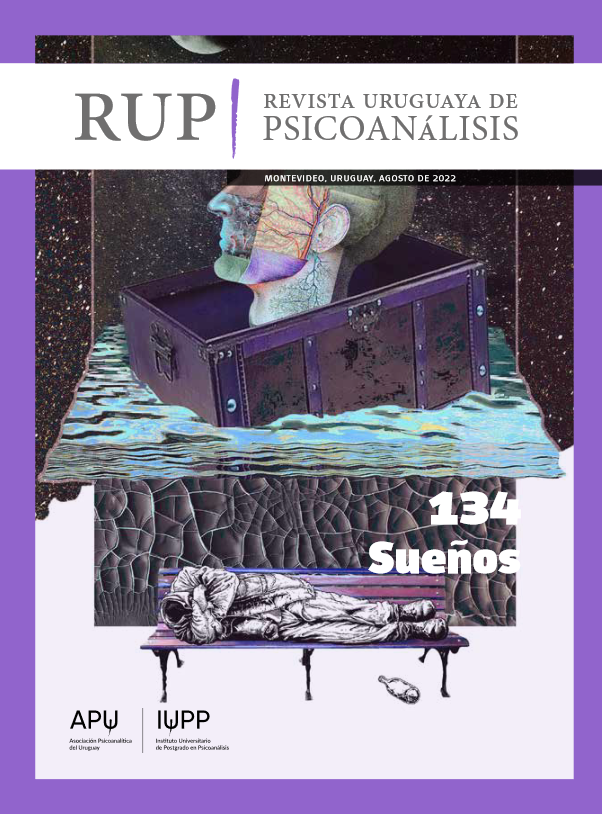Sueños,proceso analítico y cambio psíquico
DOI:
https://doi.org/10.36496.N134.a7Keywords:
Clinical material, Dream, Psychoanalytical process, Psychic change, Transference, Countertransference, Technique of dream interpretation, Dream-workAbstract
The study and interpretation of dreams marked a starting point in the identity of psychoanalysis, in a period in which our discipline was trying to begin to constitute itself as a theory, therapeutics and research method distinct from the neurology and psychology of the time. With the efforts made by Freud in the construction of the doctrine of dreams and the subsequent contributions of other psychoanalysts, working with dreams became a valuable resource for the clinic, allowing to bring into the analytical
situation unconscious aspects that otherwise might be more difficult to grasp. The author suggests that, within the framework of a sustained analytic process, there would be a relationship between the appearance and narration of some dreams and certain indicators of psychic change of which the analysand is not yet aware, being that precisely the deep revision of the oniric material and the gradual elaboration of these contents in session, within the framework of the transference, would make possible
mobilizations in the life of the patients, for which they already seemed to be prepared in an unconscious register, but which still needed an adequate way for their expression and subsequent processing.
Downloads
References
Bion, W. (1994). Emotional turbulence. En W. Bion,Clinical seminars and other works (pp. 295-305).Karnac. (Trabajo original publicado en 1976).
Etchegoyen, H. (2014). Los fundamentos de la técnica psicoanalítica. Amorrortu. (Trabajo original publicado en 1986).
Freud, S. (1976a). 29a conferencia: Revisión de la doctrina de los sueños. En J. L. Etcheverry (trad.), Obras completas (vol. 22). Amorrortu.
(Trabajo original publicado en 1933).
Freud, S. (1976b). Fragmento de análisis de un caso de histeria. En J. L. Etcheverry (trad.), Obras completas (vol. 7). Amorrortu. (Trabajo original publicado en 1905).
Freud, S. (1976c). La interpretación de los sueños. En J. L. Etcheverry (trad.), Obras completas (vol. 4). Amorrortu. (Trabajo original publicado en 1900 [1899]).
Garbarino, H. (1984). Los sueños de Dora desde la teoría kleiniana. Revista Uruguaya de Psicoanálisis, 62, 65-73.
Gardel, C. y Le Pera, A. (1935). Volver [canción]. En Volver/Sol Tropical. Víctor.
Gitelson, M. (1952). The emotional position of the analyst in the psychoanalytic situation.International Journal of Psychoanalysis, 33, 1-10.
Grassano, E. (1995). Perspectiva del sueño en la obra de Melanie Klein. En E. Grassano, N. Barenstein, S. Dvoskin, A. Kosack, S. Mascheroni, M.
Nudelman, S. Soler y R. Tula, El escenario del sueño (pp. 79-109). Paidós.
Grassano, E., Barenstein, N., Dvoskin, S., Kosack, A.,Mascheroni, S., Nudelman, M., Soler, S. y Tula, R.(1995). El escenario del sueño. Paidós.
Harris-Williams, M. (2013). Acerca de los conceptos de conflicto estético y cambio catastrófico.Temas de Psicoanálisis, 6. https://www.
temasdepsicoanalisis.org/2013/07/04/acercade-los-conceptos-de-conflicto-estetico-ycambio-catastrofico/
Horenstein, L. (2018). Ser analista hoy. Paidós.
Downloads
Published
Issue
Section
License
Copyright (c) 2022 Revista Uruguaya de Psicoanálisis

This work is licensed under a Creative Commons Attribution 4.0 International License.


 This work is licensed under a
This work is licensed under a 